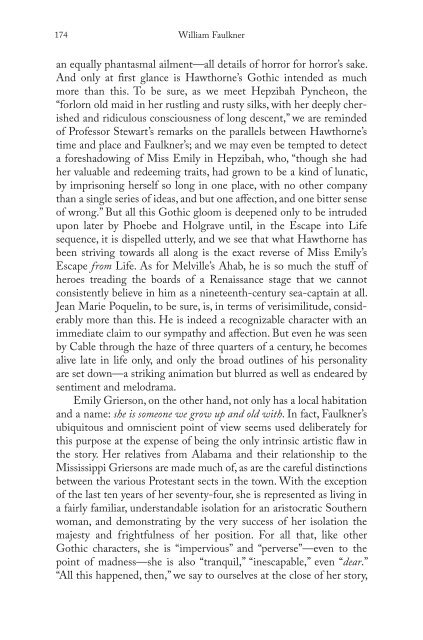Bloom's Literary Themes - ymerleksi - home
Bloom's Literary Themes - ymerleksi - home
Bloom's Literary Themes - ymerleksi - home
Create successful ePaper yourself
Turn your PDF publications into a flip-book with our unique Google optimized e-Paper software.
174<br />
William Faulkner<br />
an equally phantasmal ailment—all details of horror for horror’s sake.<br />
And only at first glance is Hawthorne’s Gothic intended as much<br />
more than this. To be sure, as we meet Hepzibah Pyncheon, the<br />
“forlorn old maid in her rustling and rusty silks, with her deeply cherished<br />
and ridiculous consciousness of long descent,” we are reminded<br />
of Professor Stewart’s remarks on the parallels between Hawthorne’s<br />
time and place and Faulkner’s; and we may even be tempted to detect<br />
a foreshadowing of Miss Emily in Hepzibah, who, “though she had<br />
her valuable and redeeming traits, had grown to be a kind of lunatic,<br />
by imprisoning herself so long in one place, with no other company<br />
than a single series of ideas, and but one affection, and one bitter sense<br />
of wrong.” But all this Gothic gloom is deepened only to be intruded<br />
upon later by Phoebe and Holgrave until, in the Escape into Life<br />
sequence, it is dispelled utterly, and we see that what Hawthorne has<br />
been striving towards all along is the exact reverse of Miss Emily’s<br />
Escape from Life. As for Melville’s Ahab, he is so much the stuff of<br />
heroes treading the boards of a Renaissance stage that we cannot<br />
consistently believe in him as a nineteenth-century sea-captain at all.<br />
Jean Marie Poquelin, to be sure, is, in terms of verisimilitude, considerably<br />
more than this. He is indeed a recognizable character with an<br />
immediate claim to our sympathy and affection. But even he was seen<br />
by Cable through the haze of three quarters of a century, he becomes<br />
alive late in life only, and only the broad outlines of his personality<br />
are set down—a striking animation but blurred as well as endeared by<br />
sentiment and melodrama.<br />
Emily Grierson, on the other hand, not only has a local habitation<br />
and a name: she is someone we grow up and old with. In fact, Faulkner’s<br />
ubiquitous and omniscient point of view seems used deliberately for<br />
this purpose at the expense of being the only intrinsic artistic flaw in<br />
the story. Her relatives from Alabama and their relationship to the<br />
Mississippi Griersons are made much of, as are the careful distinctions<br />
between the various Protestant sects in the town. With the exception<br />
of the last ten years of her seventy-four, she is represented as living in<br />
a fairly familiar, understandable isolation for an aristocratic Southern<br />
woman, and demonstrating by the very success of her isolation the<br />
majesty and frightfulness of her position. For all that, like other<br />
Gothic characters, she is “impervious” and “perverse”—even to the<br />
point of madness—she is also “tranquil,” “inescapable,” even “dear.”<br />
“All this happened, then,” we say to ourselves at the close of her story,
















